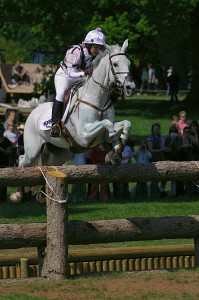What is Eventing?
Eventing is commonly seen as an equestrian triathlon, in that it combines different disciplines dressage, cross-country and show-jumping into one competition. It has two main formats, the one-day event (ODE) and the three-day event (3DE), and has also been referred to as Horse Trials, and Combined Training.
DRESSAGE
The dressage phase (held first) comprises an exact sequence of movements ridden in an enclosed arena (20 x 40 meters or 20 x 60 meters). The test is judged by one or more judges who are looking for balance, rhythm and suppleness and most importantly, obedience of the horse and its harmony with the rider. Each movement in the test is scored on a scale from 0 to 10, with a score of “10” being the highest possible mark. The dressage mark (score) is then converted into penalty points.
CROSS-COUNTRY
The next phase (i.e. Phase D only see below regarding Long vs. Short format), cross-country, requires both horse and rider to be very fit and brave plus trusting of each other. This phase consists of approximately 12-20 fences (lower levels), 30-40 at the higher levels, placed on a long outdoor circuit. These fences consist of very solidly built natural objects (telephone poles, stone walls, etc.) as well as various obstacles such as ponds and streams, ditches, drops and banks, and combinations involving several jumping efforts – based on objects that would commonly occur in the countryside. This phase is timed, with the rider required to cross the finish line within a certain time frame (optimum time).
Penalties are incurred due to: Crossing the finish line after the optimum time, and for lower levels going too fast, refusals, falls, and other disobediences at jumps. The penalties for this phase are weighted more heavily as compared to the other phases of competition to emphasize its importance.
SHOW JUMPING
The last phase, show jumping, tests the technical jumping. In this phase, 12-20 fences are set up in a ring with the competitor being timed. Typically these fences are brightly colored and consist of elements that can be knocked down, unlike cross-country obstacles. Penalties are given out for disobediences, falls, knockdowns and for going over the optimum time. At the end of the competition, the rider with the fewest combined penalties is the winner.
SHORT (VS) LONG FORMAT
Recently, the phases A (1st Roads & Tracks), B (Steeple-chase), and C (2nd Roads & Tracks) have been excluded on cross-country day from 3-day events. The primary reason for excluding these phases was that the Olympic Committee was considering dropping the sport of eventing from the Olympics because of the cost and large area required for the speed and endurance phase with a steeplechase course and several miles of roads-and-tracks. To prevent the elimination of the sport from the Olympics program, the “short format” was developed by the FEI, which excluded the phases A, B, and C on cross country day, while retaining phase D. The last Olympic Games that included the long, or “classic”, 3-day format were the 2000 Summer Games in Sydney. The one- and two-star level events will offer “with steeplechase” (the long format), however, three-star events will only offer the short format. All four-star competitions have switched to the short format: Badminton and Burghley began running the short format. Currently all of the four-star competitions have now switched to the short format.
INTERNATIONAL COMPETITION
International events have specific categories and levels of competition. CCI (Concours Complet International, or International Complete Contest) is one such category and defines a three-day event that is open to competitors from any foreign nation as well as the host nation. CCI : International Three-day event (Concours Complet International). CIC: International One-day event (Concours International Combin). CCIO: International Team Competitions (Concours Complet International Officiel). Includes the Olympics, the World Championships, the Pan Am Games, and other continental championships. The levels of international events are identified by the number of stars next to the category: CCI* is for horses that are just being introduced to international competition. CCI** is for horses that have some experience of international competition. CCI*** is the advanced level of competition. CCI**** is the very highest level of competition (i.e.: Badminton, Burghley, Rolex, Worlds, Olympics) and is the ultimate aim of many riders.
CANADIAN COMPETITION
The Canadian divisons are as follows (heights/widths/etc. are approximate):
- Pre-Entry Entry (equitable to USEA Beginner Novice)
- Pre-Training (equitable to USEA Novice): XC: fences maximum height 0.91 m ditch 1.50 m drops 1.10 m; Stadium fences: 0.96m
- Training: XC: fences maximum height 1.00 m ditch 1.80 m drops 1.40 m; Stadium fences: 1.05 m
- Preliminary: XC: fences maximum height 1.10 m ditch 2.80 m drops 1.60 m; Stadium fences: 1.15 m
- Intermediate: XC: fences maximum height 1.15 m ditch 3.20 m drops 1.80 m; Stadium fences: 1.20 m
- Advanced: XC: fences maximum height 1.20 m ditch 3.60 m drops 2.00 m; Stadium fences: 1.25 m

